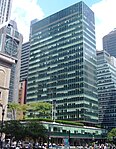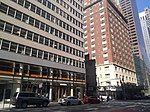Weylin Hotel
1921 establishments in New York City1956 disestablishments in New York (state)Cultural history of New York CityDefunct hotels in ManhattanHotel buildings completed in 1921 ... and 3 more
Hotels established in 1921Madison AvenueMidtown Manhattan
The Weylin Hotel was a hotel at 527 - 531 Madison Avenue and 40 - 54 East 54th Street in New York City. It was on the southeast corner of 54th Street. The structure was sixteen stories tall and opened in March 1921. The building fronted sixty-one feet on Madison Avenue and one hundred forty-eight feet on 54th Street. It contained 125,000 square feet (11,600 m2) of space.
Excerpt from the Wikipedia article Weylin Hotel (License: CC BY-SA 3.0, Authors).Weylin Hotel
Madison Avenue, New York Manhattan
Geographical coordinates (GPS) Address Website Nearby Places Show on map
Geographical coordinates (GPS)
| Latitude | Longitude |
|---|---|
| N 40.760036111111 ° | E -73.973525 ° |
Address
527 Madison Avenue
Madison Avenue 527
10022 New York, Manhattan
New York, United States
Open on Google Maps






